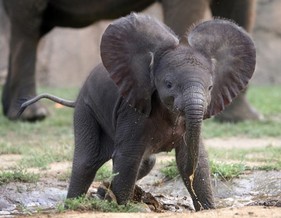And Now for the Main Act... The African Elephant!
 Baby African Elephant
Baby African Elephant
African Elephants are a keystone species in Kruger National Park. A keystone species is a species whose importance to its ecosystem is disproportionately large to its abundance in that ecosystem. All ecosystems have keystone species, and some may have more than one. But in the case of Kruger National Park, the African Elephant is essential to preserving the savanna landscape. African Elephants are destructive herbivores, meaning they trample and uproot many of the trees that they eat off of. When they trample trees and shrubs, this allows grasses to grow, making the landscape a savanna rather than a forest. These grasses also provide food to many other herbivores in Kruger National Park. Additionally, water can collect in their huge footprints and can be a source of water for other animals. Large animals have large excrements, and the African elephant is no exception. The large abundance of elephant feces gets absorbed by the soil makes it more nutrient-rich than it would be without it. Unfortunately, poaching has become an increasing problem for the African elephant, and the extinction of such an essential animal could cause a collapse in the savanna biome in Kruger National Park.
Below is a video of Duke, Kruger National Park's largest elephant. Throughout the video you can see Duke eating various plants and trampling over shrubs and trees as he walks around.
Below is a video of Duke, Kruger National Park's largest elephant. Throughout the video you can see Duke eating various plants and trampling over shrubs and trees as he walks around.
For More Information on the African Elephant, Visit: http://www.defenders.org/elephant/basic-facts
Photo Source: http://arkforanimals.blogspot.com/2011/08/baby-animals.html
